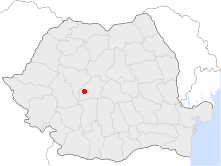Galeş
Galeş | |
|---|---|
Village | |
 Location of Galeş | |
| Country | |
| County | Sibiu County |
| Status | Village |
| Government | |
| • Mayor | Banciu Teodor Dumitru (Sălişte) (National Liberal Party) |
| Area | |
| • Total | 226.78 km2 (87.56 sq mi) |
| Population (2007) | |
| • Total | 331 |
| • Density | 26/km2 (70/sq mi) |
| Time zone | UTC+2 (EET) |
| • Summer (DST) | UTC+3 (EEST) |
Galeş (Hungarian: Szebengálos; German: Gallusdorf) is a village under the administration of the town of Sălişte in Sibiu County, Transylvania, Romania, in the Cindrel Mountains, 24 km west of the county capital Sibiu, in the Mărginimea Sibiului ethnographical area.
Demographics
According to the 1992 census, there were 346 inhabitants of Galeş. The 2002 Census of neighbouring Sălişte indicates that the ethnic composition of Galeş is likely to be in the order of 92% Romanians, 6% Roma and 2% made up of other ethnicities. Most Romanians are Orthodox. The official Sălişte council website in 2007 refers to 331 inhabitants.
The village
The village of Galeş is situated in the heart of the Marginimea Sibiului. This is an area which comprises about 20 village and town communities that have a strong Romanian cultural and ethnic identity. The area sits on the northern arc of the Carpathians, close to the Valea Oltului, a river path leading directly south to the plains of Wallachia, in Southern Romania. The area was a Romanian outpost on the edge of the Transylvanian Saxon land of Siebenbürgen. Today, it is hailed in mainstream Romanian society as a source of the pure Romanian ethnological, cultural, architectural and historical heritage.
Galeş village is similarly laid out to a Saxon village and shares many of the same architectural styles. Indeed, historical records show that there was a small ethnic Saxon population in the village, which in the late 19th Century reached ten families. The main difference is that whilst the village conforms to a ribbon style which follows the Râul Negru stream uphill between Salişte and Tilişca, the stream does not sit in the centre of the road, but off to one side, behind the houses. This was probably a sensible thing for the villagers to do given the large and fast-flowing volume of water that comes down from the Munţii Cindrel.
Many of the village houses are styled similarly to the Saxon style, sitting end-on to the street, painted in a rich variety of ochres, greens and blues, with distinctive hipped roofs. The main difference with the sober Saxon facades is that many of Galeş’s house fronts have fanciful flourishes of Hungarian Baroque. The houses themselves are built to a format, with their cobbled courtyards, winter and summer kitchens, vegetable patches and timber frame barns enclosing the rear end of the courtyard. Behind the barns lie a further vegetable plot and an orchard, sometimes with a row of walnuts at the far end. The village is enclosed and neatly protected by steep valley sides which, when climbed, give stunning views over the hills, valley bottom and to the snow-capped peaks of the Carpathians in the far distance.
Economy
Traditionally the main occupation was shepherding and related activities. Today this occupies a smaller percentage of the workforce, but remains important alongside other agricultural activities. There remains a working water mill. The Rural Museum, organised in 1968, has an ethnographic exhibition and folk art from the area and an open air sector. There is a thriving hat-making workshop at house nr.43, making distinctive black felt hats worn by local men. Radu or Dan Ilieş let visitors watch them as they work. (Contact either of them on 0040 269 553431).
Famous people
Ioan din Galeş Confessor priest, John of Galeş, celebrated on the Feast Day of October 21st
Image Gallery
-
The beautiful village of Galeş nestled in the foothills of the Cindrel Mountains
-
The village church of Galeş
-
A typical village street - the approach to the Church
-
Template:Ro icon Schitul Foltea. A small church and nun's retreat, situated along a wonderful woodland walk up the side of the valley. (It can be reached by following a path up the side of the hill at the well which is the boundary point separating Galeş from neighbouring Sălişte)
-
Template:Ro iconSchitul Folteanun's housing. Although choosing to lead a more solitary lifestyle, the nuns are friendly and inviting
-
A colourful local resident
-
A typical village house facade
45°48′N 23°52′E / 45.800°N 23.867°E






